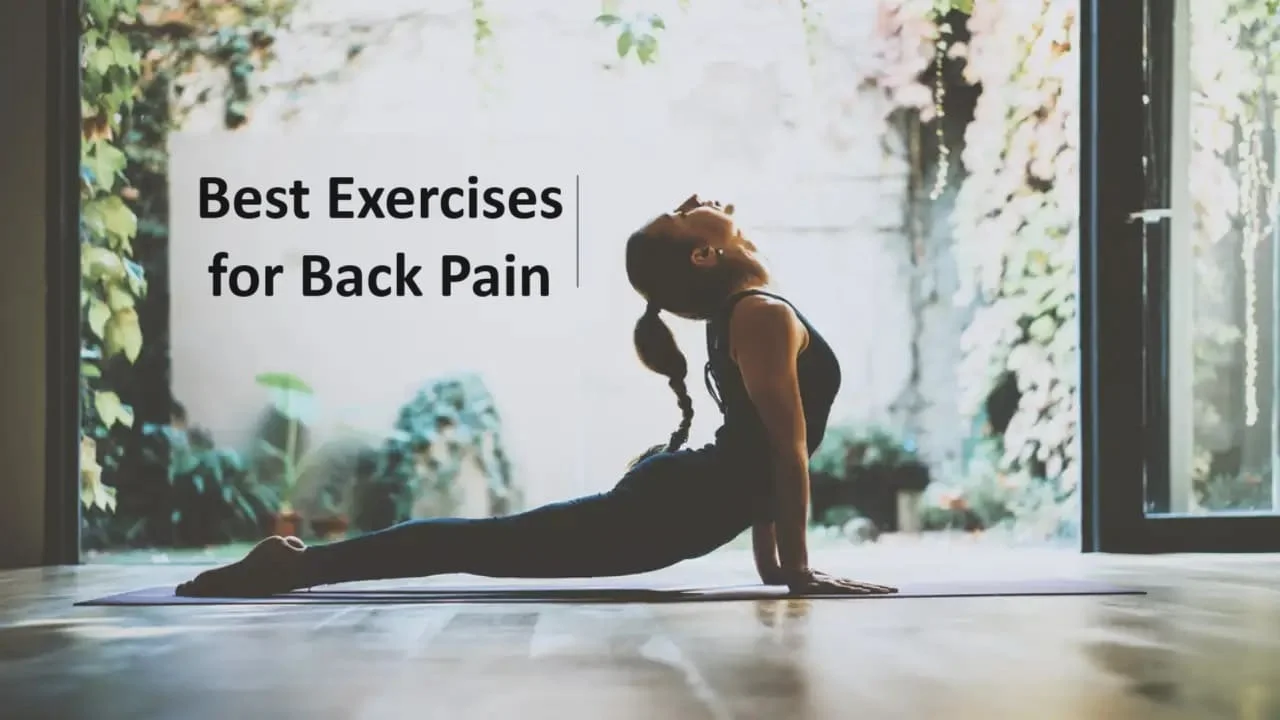Exercise is widely recognized as a cornerstone in the management and prevention of back pain. However, not all exercises are created equal, and choosing the appropriate ones can significantly impact pain relief and long-term back health.
This guide aims to provide a comprehensive overview of the best exercises for addressing back pain, focusing on strengthening muscles, improving flexibility, and enhancing posture.
What is Back Pain?
One of the most frequent reasons people visit their doctor and miss work is back pain. The feeling of back pain may change, ranging from a sudden, sharp pain to a dull, ongoing pain.
Back pain comes in two varieties:
The duration of acute back pain can range from a few days to many weeks. When self-care is carried out, it typically goes away on its own in a few days without causing permanent function loss.
Pain that continues for 12 weeks or more after treatment for an initial injury or underlying cause of back pain is referred to as chronic back pain.
Introduction:
People frequently experience back pain. People of all ages now frequently experience back pain, particularly in modern times. Back pain can be due to various factors, but two primary causes are extended periods of stress and sitting. Injuries, bad posture, and age-related physical and psychological changes are additional factors.
As people age, back pain (BP) becomes more common. Although there are many different kinds of back pain, mechanical back pain is particularly common and is associated with long periods of sitting, low vitamin D levels, aging, and inactivity. Exercise is a great way to prevent and often reduce pain in your back. The back and supporting muscle exercises can help you stretch and strengthen your back.
Back pain exercises are an important part of your treatment plan, medical care, and physical therapy. Many exercises can help reduce pain in the back while also improving your general strength and flexibility. Exercise for back pain can help you recover from pain and its related symptoms by strengthening your back and making it easier to carry out regular tasks.
You can get relief from back pain and increase the flexibility of the affected muscles by doing specific stretches and exercises. Exercises strengthen the core, resulting in improved physical performance. Exercise helps release tension, improve flexibility, and reduce muscle tightness in the back. Exercises improve posture, and strong glutes provide back support during sitting, standing, and walking.
Repeat each exercise a few times when you first start. Increase the number of times you perform an exercise as it gets easier for you. Speak to a physical therapist or another healthcare team member about safe activities if you’re starting an exercise program because of ongoing pain in the back or following a back injury.
This post will discuss some of the best stretching and strengthening exercises for the muscles that surround the back. These exercises are easy to work into your daily routine because they are simple but beneficial.
What is the proper way to stretch your back?
Your lower back’s tight muscles may become flexible with some yoga poses and light stretches. If you have any kind of injury or health issue, proceed with extra care and precaution. It is recommended to consult your doctor before beginning any new exercise protocol, especially if you believe that your pain may be related to a recent injury.
Avoid sudden movements that could hurt or strain your back, and use low-impact exercises to strengthen your abdominal and back muscles.
These stretches can be performed for a suitable number of repetitions each day. However, if you’re in severe discomfort or your lower back pain seems to be getting worse, it might be wise to skip stretching for a day.
While you perform these stretches, take your time and pay attention to your breathing. Make use of your breath to help make sure you don’t strain or overdo it. during each pose or stretch, you should be able to breathe easily and comfortably.
Stretch your body one side at a time.
How Exercise Helps Back Pain:
Exercises performed during back pain physiotherapy can strengthen your back, legs, and stomach muscles as well as support your spine and relax back pain. The three main components of an exercise program for general chronic back pain are aerobic fitness, muscular strength, and flexibility. While flexibility improves the range of motion and movement, aerobic exercise increases blood flow and nutrients to the back’s soft tissues, and core muscular strength can help support the lumbar spine.
Exercise strengthens, stretches, and repairs the back muscles. Stiffness reduces and the healing process is helped by increased blood flow and nutrition. There is a lower risk of injuries and back pain because ligaments and tendons are more flexible and the connective fibers won’t tear under stress.
For low back pain sufferers, physical activity is important in helping them carry out their everyday tasks. However, the success rate of various exercises is different. Remember, too little or too much exercise may worsen low back pain rather than help it go away.
Advantages of exercise for back pain:
The following are the advantages of regular exercise:
- Muscle relaxation
- Reduce pain
- Improve motion
- Improve flexibility
- Helps to strengthen weak muscles.
- Reduce tension or tightness.
- Improving coordination.
- Improve your balance
- Exercise may help you to restore mobility.
- Improves daily activity function
- Improve posture
The Best Exercises for Back Pain:
The following exercises are helpful to many people. Make any necessary position adjustments for your comfort. Try to perform these workouts daily. Perform a few of each time, to begin with, to adjust yourself to them, and then progressively increase the amount you do.
Knee to chest stretch
- Put your feet flat on the floor, bend your knees, and rest on your back to get started.
- Place your hand behind your knee or just below your kneecap.
- Bring your knee up to your chest now.
- For a few seconds, hold it.
- After that, drop your leg.
- Then return to your neutral position.
- Next, relax.
- Perform the exercise on the opposing leg.
- Do this five to ten times over.
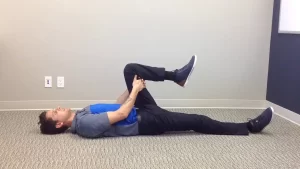
Lower back rotational stretch
- A comfortable spot to start is on your back.
- Put both of your knees bent.
- On the floor, keep your feet flat.
- Inhale deeply.
- Maintain your shoulders securely planted on the ground.
- Bend over on one side knee.
- Take a look at the opposite side.
- Take a few seconds to hold it.
- Next, gradually take a step back to your neutral posture.
- After that, relax.
- Switch sides slowly.
- Do this five to ten times over.
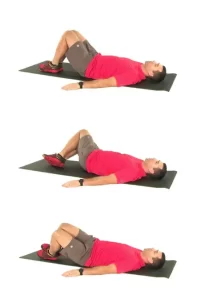
Seated spinal twist
- Place both legs out in front of you while taking a comfortable seat on the floor.
- Next, bend your left knee and place it flat on the ground on your right thigh’s outside part.
- At this point, position your right arm outside of your left leg.
- Hold your hand behind you.
- Turn your body to the left, very gently.
- For a short while, hold it.
- Return to your neutral posture after that.
- Next, relax.
- Continue on the opposite side.
- Do this exercise five to ten times.
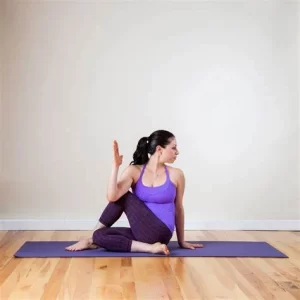
Pelvic tilt
- Begin by lying down on the bed or table and relaxing.
- Now bend your knees.
- Hold your hands by your sides or place them on your chest.
- Your abdominal muscles should be tight.
- For a short while, hold it.
- Return to your neutral posture after that.
- Next, relax.
- Do this exercise five to ten times.
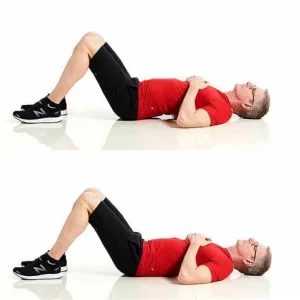
Pigeon Pose
- Place your hands on your knees on the floor while you begin in a comfortable position.
- Now squeeze your abdominal muscles.
- Then, bring your left knee forward and extend it to the left.
- Put your right toes under and move your right leg backward.
- Let your left toes extend.
- Maintain a straight back and raise your head.
- Maintain this position for a short amount of time.
- Return to your neutral posture after that.
- Next, relax.
- Do this exercise five to ten times.
- Repeat the exercise with the other leg.
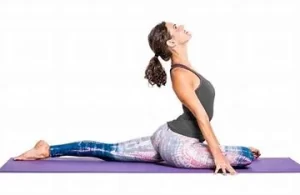
Child’s Pose
- Begin in a comfortable kneeling position.
- Keeping your hips and knees in position.
- Inhale and bend forward to bring your body down.
- Put your forehead down on the ground.
- It’s okay to hold your arms straight out in front.
- For a short amount of time, maintain this position.
- Breath out.
- Then return to your neutral position.
- Next, relax.
- Do this exercise five to ten times.
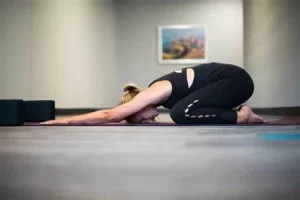
Bridges
- Lay down on the bed in a comfortable position to begin.
- Right now bend your knees with your feet flat on the bed.
- Next, tighten the muscles in your abdomen.
- Raise your upper body.
- Please maintain your arms by your sides.
- Hold on for a few seconds.
- Bring your body down.
- Then return to your neutral position.
- Next, relax.
- Do this exercise five to ten times.
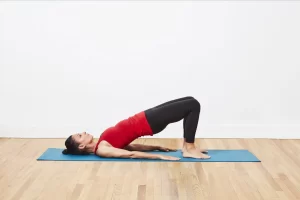
Cat-Cow
- Start by putting your hands and knees on the ground in the tabletop position.
- Make sure your back is straight.
- Stay grounded with both hands and feet.
- Breathe in, lift your head, and allow the air to fill your belly.
- For a short while, maintain this posture.
- After that, release the breath, bend your back toward the ceiling, and pull your chin into your chest.
- Your lower back is gently stretched out.
- For a short while, maintain this posture.
- After that, return to a neutral position.
- Then relax.
- Perform this exercise five to ten times.
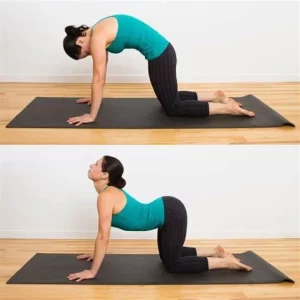
Hip flexor stretch
- Started by working both knees together.
- Now take a step forward and bend your knee to a 90-degree angle.
- Your hands can be supported if needed by resting them on the front knee.
- Maintaining the upper body straight.
- Next, extend your forward body until you feel pressure.
- Keep your posture like this for a few seconds.
- Next, return to a neutral position by taking a step back.
- After that, relax.
- Do this five or ten times.
- Repeat with switching legs.
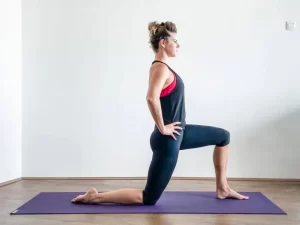
Piriformis stretch
- Place yourself on the ground on your back to get started.
- Make sure that you bend each knee.
- Keep your feet level with the ground.
- Now place your right ankle against your left thigh.
- Place your hands on the left side of your leg.
- Make your leg closer to your upper body.
- Maintain it for just a short time.
- Then, go back to your neutral position.
- Next, relax.
- Do this exercise five to ten times.
- Repeat on the other side.
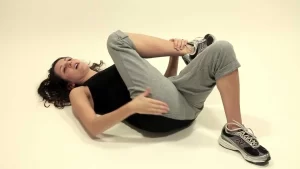
Sphinx stretch
- Lay down on your stomach with your elbows under your shoulders and your hands straight out in front of you with the palms down.
- Place your feet a little apart.
- It is likely to be your big toes to touch.
- Gently contract your thighs, lower back, and buttocks as you raise your head and chest.
- Breathe fully and maintain a strong lower back and abdomen.
- Your pelvis should be securely planted on the ground.
- You can close your eyes gently or look directly ahead.
- For a short while, maintain this position.
- Then return to your neutral position.
- Then relax.
- Do this exercise five to ten times.
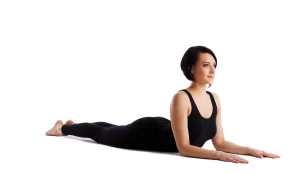
Lying lateral leg raises
- On the bed, begin in a comfortable side-lying position.
- Make sure both of your legs stay straight.
- Now lift one leg straight up without moving the rest of your body.
- Hold on for a short while.
- Then lower your leg slowly.
- Return to your neutral posture after that.
- Next, relax.
- Do this exercise five to ten times.
- Perform the exercise on the opposing leg.
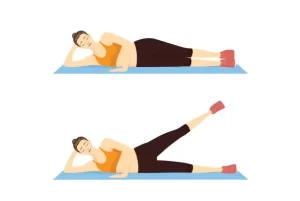
Partial curls
- Begin by lying down on the ground.
- Now bend your knees.
- Keep your feet flat on the ground.
- Cover your head with your hands.
- Take a breath deeply.
- Then raise your shoulders a few inches off the ground gradually.
- Hold on for just a little while.
- Next, slowly go down.
- Return to your neutral posture after that.
- Next, relax.
- Do this exercise five to ten times.
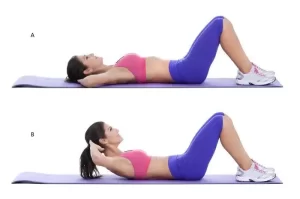
Superman
- Start by lying down on your stomach and relaxing.
- Keep your legs straight and raise your arms in front of you.
- keeping a neutral head posture.
- Now, carefully raise your legs and arms off the ground to a comfortable height.
- Rise your stomach a little bit off the ground to contract your core muscles.
- You’re feeling contractions in your lower back muscles.
- For just a short time, maintain this position.
- Then Return to your neutral posture.
- Next, relax.
- Do this five to ten times over.
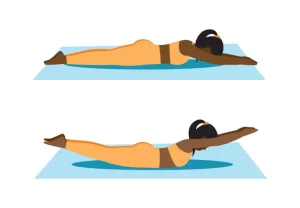
The Supine Twist
- While lying on your back, bend your knees and plant your feet flat on the ground.
- Put your hands out to the sides to form a T shape.
- As you slowly rotate your knee to one side, keep your shoulders flat on the floor.
- Hold this posture for a short while.
- Next, return your knees to the center of the body.
- Then slowly return to your neutral position after that.
- Then relax.
- Repeat this five to ten times.
- Perform the exercise on the opposing leg.
- As you move to each side, place a cushion or stack of blankets under your knees if the stretch is too much for you.
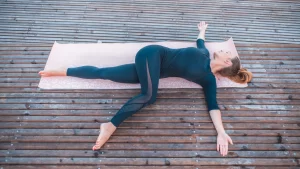
Forearm Plank
- Lie down on the floor and relax for a bit.
- Straight under your shoulders, place your forearms.
- Next, gradually lift your body off the ground by applying pressure to your knees and forearms
- Raise the body to a relaxed posture.
- As you lift your knees, pull your toes under.
- That makes a straight line with your body.
- For a few seconds, maintain this posture.
- Next, gradually take a step back to your neutral posture.
- After that, relax.
- Repeat this five to ten times.
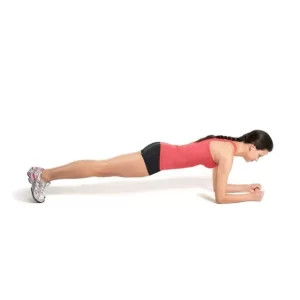
Bird Dog
- Place yourself in a tabletop position and begin by relaxing on all fours.
- Placing your hands under your shoulders and your knees below your hips now.
- Maintain a neutral spine position.
- Squeeze the area between your shoulder blades.
- Then, raise your right arm and left leg to the ceiling.
- Maintain a parallel posture with your hips and shoulders.
- For a few seconds, maintain this posture.
- Afterward, go back to where you were before.
- Then relax.
- Perform this exercise five or ten times.
- Do the exercise again on the opposite side of your body.
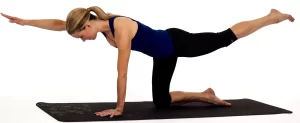
Back extensor exercise(cobra pose)
- Your palms should be flat on the floor close to your shoulders.
- Your elbows should be straight back as you hold your sides.
- Step back for a moment and look straight down at your mat while keeping your neck in a neutral position.
- Press your pubic bone into the ground.
- Take a breath to raise your chest off the ground.
- Maintain your low ribs on the ground while rolling your shoulders back.
- Be sure to keep your elbows taking on your sides.
- Prevent them from going in different directions.
- Maintain a neutral neck posture.
- Keep your eyes fixed on the ground.
- For a few seconds, maintain this posture.
- Breathe out to return to the floor.
- Following that, go back to your neutral posture.
- After that, relax.
- Perform this exercise five or ten times.
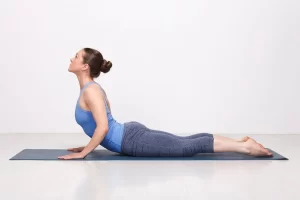
Foam rolling
- Position the foam roller parallel to the spine at the base of the shoulder blades.
- Knee bent, feet flat, rest hips and glutes on the floor.
- With your elbows spread wide, gently support the back of your head.
- Raise your pelvis upward toward the ceiling while contracting your abs.
- Then, slowly move your spine along the roller while paying attention to your breathing.
- Pause where your back gives you the most sensation, take a deeper breath through your nose, and then slowly release the breath via your mouth or nose.
- You’ll get a sense of where to stop and spend more time by going back and forth.
- If you find a particularly painful spot, stay there and move your spine into flexion and extension over the roller by lifting your chest up and down and using your abs to prevent your spine from extending too much.
- After that, return to your neutral position.
- Then relax.
- Repeat this five to ten times.
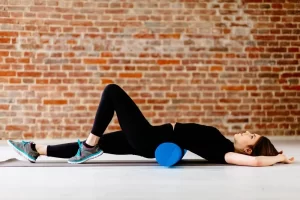
Circle Plank
- The forearm plank is the starting position.
- A forearm plank on the ball should be performed with the elbows exactly under the shoulders.
- Try putting your toes on the ground.
- The body should then remain in a straight line from the shoulders to the heels with the core engaged.
- Make small clockwise circles with your elbows on the ball while contracting your abs.
- Make every effort to stay in contact with the rest of the body.
- For one repetition, repeat in the opposite direction.
- After that, return to your neutral position.
- Then relax.
- Repeat this five to ten times.
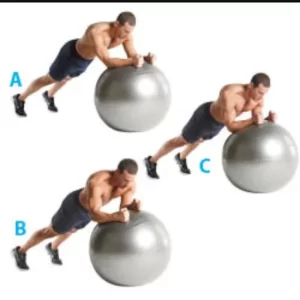
Overhead arm reach
- You may start off standing or sitting down.
- Lean the arms out above your head.
- Stretch both arms upward while bending to the right.
- Using the right hand, slowly extend the left arm to the right to deepen the stretch.
- Get back to where you were before.
- Then relax.
- Do this exercise five to ten times.
- Repeat the opposite side exercise.
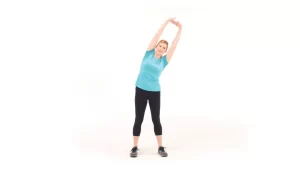
Cow-Face Pose (Gomukhasana)
- With your legs fully extended in front of you, sit with your spine straight.
- You can sit on a yoga mat or on the floor.
- Make sure that your legs are fully in contact with the floor by bringing your feet and legs together so that the big toes of each foot come into contact.
- No portion of your legs should be in the air.
- Put your palms down, face up, on the ground on each side of your hips.
- After that, raise your left leg and bend your right leg under your left.
- Then, bend your left leg, cross it over your right knee, and rest it next to your right hip.
- Your left leg is now positioned above your right leg, and both of your legs are bent.
- Raise the left arm over the head.
- Now, put your left palm behind you, bending your elbow so that it rests between your shoulder blades.
- A little over, lower your right arm behind your back, raise it, and position it in the space between your shoulder blades.
- Your right elbow is now pointing down behind you, and your left elbow is behind your head, pointing upward.
- Your right palm is open, pointing outward, while your left palm is closed, contacting your spine.
- As gently as you can, press your palms together.
- Make sure both hands connect behind you to achieve the ideal pose.
- Maintain a straight position with your neck and spine while keeping your palms together or as near as possible.
- Breathe deeply and slowly while holding this position.
- Find a place where you can breathe comfortably while maintaining the posture, your neck and spine should be straight, and that is your best position.
- Hold this position for a few seconds.
- As you breathe out, release your hands.
- After that, return to your neutral position.
- Then relax.
- Repeat this five to ten times.
- Repeat the opposite side exercise.
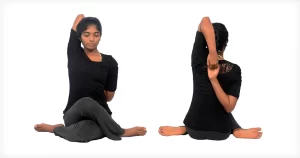
Happy Baby (Ananda Balasana)
- Lie flat on your back on the ground or a matting.
- Maintaining your head flat on the mat, bend your knees to a 90-degree angle toward your chest.
- Turn your feet so that the soles face the ceiling.
- With the extended hand, grab and hold your feet either inside or outside.
- In the direction of your arms, bend both of your knees out.
- As you gently rock forward and backward, hold your hand with your heels (as if you were a happy baby).
- Take deep breaths in and out while holding this posture for a few moments.
- After that, return to your neutral position.
- Then relax.
- Repeat this five to ten times.
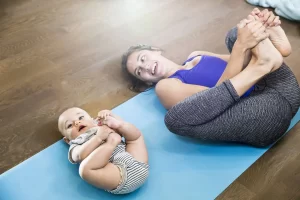
Straight Leg Raise
- Begin in a comfortable lying down position on the floor or table.
- Now slightly bend your knee.
- Then raise your leg gradually.
- While the knee on the other side stays straight.
- Next, hold for a short amount of time.
- Then lower your leg.
- Return gradually to your neutral posture.
- After that, relax.
- Repeat on the opposite side.
- Five to ten repetitions for each side.
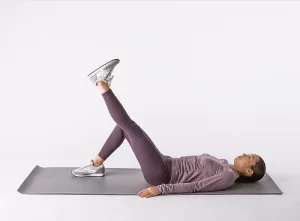
Prone leg raise
- If it helps you feel more comfortable, you may want to turn your head to one side while lying face down.
- Raise one leg slightly off the ground while maintaining a level hip range by contracting your stomach and buttocks.
- Maintain this position for a short amount of time.
- Then, go back to your neutral posture.
- Then relax.
- On the other leg, repeat the exercise.
- Five or ten repetitions of this exercise are recommended.

Lying Hamstring Stretch
- Put both of your knees on the ground and bend them.
- Elevate one leg above the floor and raise it to your chest.
- Hold your hands slightly below your knee, behind your thigh.
- Once you have straightened your leg out, slowly raise it to your head until you feel a stretch.
- If you have trouble holding your hands behind your leg, you can loop towels around your thigh.
- Bring your leg in toward you while holding it with your hand.
- After a short amount of time, release the hold.
- Then, go back to your neutral posture.
- Next, relax.
- Do five or ten repetitions of this exercise.
- On the other leg, repeat the exercise.
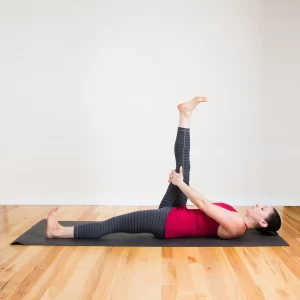
Modified Side Plank
- Rest on your side on the ground, with your legs straight.
- With your forearm outstretched on the ground in front of you, your elbow should be exactly under your shoulder.
- Pull your hips up off the ground and squeeze your abdominal muscles.
- Maintain a straight body and stay in this posture for a few seconds.
- Then, go back to your neutral posture.
- Next, relax.
- Do five or ten repetitions of this exercise.
- On the other side, repeat the exercise.
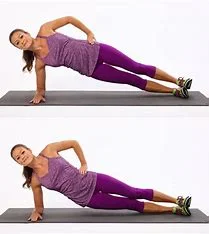
Hand-to-Big-Toe Stretch in Recline (Supta Padangusthasana)
- While resting flat on your back, lift your right leg toward your face.
- Depending on how tight your hamstrings feel, place your hands behind either your calf or your thigh.
- Maintain a planted hip and an engaged opposite leg.
- Keep your shoulders and head down on the ground.
- Now, while maintaining your opposite hip planted, let your right leg fall out to the right.
- Only stretch your right leg out to the side as far as it won’t raise your hip on the other side.
- Maintain this position for a short amount of time.
- Returning your neutral posture after that.
- After that, relax.
- Do five or ten repetitions of this exercise.
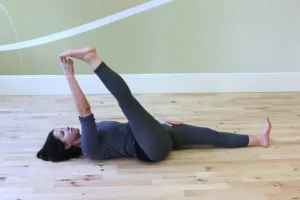
Wall Sits
- Take a standing position with your back to the wall, your heels to the foot, and your face away from it.
- After lowering yourself to a slightly bent knee position as well presses your back flat against the wall.
- For a few seconds, maintain a sitting position while gently pressing your lower back against the wall.
- Then returning to the wall by sliding.
- After that, relax.
- Do five or ten repetitions of this exercise.
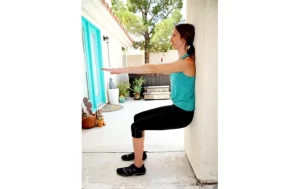
Clamshell
- You lie on your side to begin.
- With your elbow bent, lie on your left side.
- Next, hold the support up to the head with your left hand.
- Place your right leg and foot on top of your left, then bend your knees to create a 45-degree angle.
- For balance, place your right hand on your hip or lightly on the ground in front of your body.
- Next, slowly raise your right knee toward the ceiling while keeping your feet close to your body.
- Make use of your glutes to start the movement.
- Squeeze your core and raise your lower right leg back up to meet your left.
- Hold this posture for a short amount of time.
- After that, take a neutral stance.
- Then unwind.
- Perform the exercise on the opposite leg.
- Perform this exercise ten or five times.
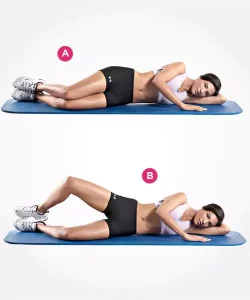
Standing Roll-Down
- Step forward about half a foot, keeping your heels against the wall as you stand there.
- While lowering your abdomen, keep your core supported.
- Maintain your arms at your sides while lowering your shoulders.
- Take a deep breath, pull your chin into your chest as you exhale, and start bending your body down, one vertebra at a time, beginning at the neck.
- Your head, neck, and shoulders will all bend forward together with your spine.
- To avoid straining your hamstrings, lower as far as you can.
- Additionally, you can flex your knees while your hands are on the ground.
- Use your abdominal muscles to help raise yourself back up to standing and keep your shoulders down, move the vertebrae of your spine one by one to rewind from the bottom up.
- After that, take a neutral stance once more.
- Then relax.
- Perform this exercise ten or five times.
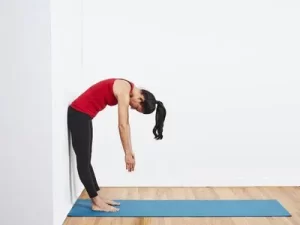
Figure Four stretch
- Place yourself on your mat.
- With your hands by your sides, knees bent, feet flat, lie straight up.
- Raise your right leg, cross it over your left knee, and rest your foot there while maintaining a bend in your knee.
- With your feet flexed and your head and shoulder relaxed on the mat, grab both hands behind your left knee and pull that leg toward your body.
- Your right hip will start to stretch.
- After breathing deeply and holding for a few while.
- Then return to your neutral position.
- Then relax.
- Perform this exercise ten or five times.
- Repeat the exercise on the other leg.
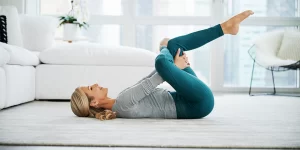
Simple hamstring stretch
- On your mat, take an upright position with your legs straight in front of you and your feet extended.
- As you release your breath, bend forward and spread your arms out in front of you.
- Check that your back is extended, not arched over.
- Lower your head toward your lower body and extend your hands as far along your legs as is comfortable for you.
- If necessary, you can flex your knees to extend your reach.
- Hold this posture for a short amount of time.
- After that, return to your neutral position.
- Then relax.
- Continue with the exercise using the opposite leg.
- Perform this exercise ten or five times.
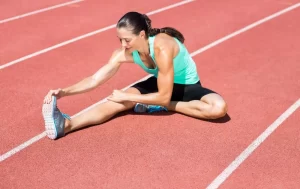
Supine Twist Back Stretch
- Lying on your back, flex your knees and place your feet level on the floor.
- You should feel a light stretch as you lower your legs to the floor while maintaining a flat back on the ground.
- Rotate your hips to the left.
- Take a few moments to hold.
- Reposition yourself to where you were before.
- Once you feel a slight stretch in your legs, rotate your hips to the right and lower them to the floor.
- Take a few moments to hold.
- After that, return to your neutral position.
- Then relax.
- Repeat this exercise 5-10 times.
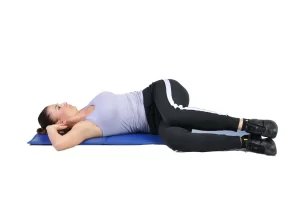
Walk
- Walking might assist release pressure when your lower back has opened up, but you should exercise carefully.
- Your activity level and your body’s tolerance for walking will determine how far and how often you walk to relieve your back pain.
- Starting at a small distance, make your way up.
- Don’t just keep going if you feel uncomfortable while you’re walking.
- Pause and inhale deeply.
- Think about making an effort to relax and release your muscles.
- Sometimes people don’t realize how tightly they are gripping their bodies and how much they have to protect until they take that deep breath and try to relax.
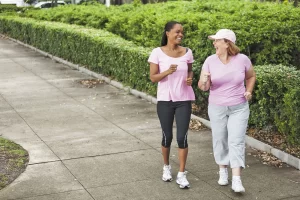
Which safety measures must be taken when exercising?
It is important to exercise safely and correctly, taking into consideration your particular situation. Back pain should only be exercised after consulting with a physician or physical therapist.
- Before working out, warm up and stretch gently.
- When doing the exercise, keep your posture correct.
- Avoid painful workouts.
- If you are uncomfortable while exercising, stop.
- Between exercises, take a break.
- Stay hydrated.
- Every exercise should be performed according to protocol, which calls for stretches before, holds between, and the right amount of repetitions for each exercise.
- Avoid wearing tight clothing when working out and dress comfortably to allow your body to move freely.
- It’s okay if it hurts as you stretch the tight muscle. But you shouldn’t feel any acute or sharp pain during the stretch.
- Holding your breath while exercising is never good. When you exercise, it’s advised that you take deep breaths and slowly release them through your mouth. Your muscles become more stiff when you hold your breath during exercise, which increases your risk of high blood pressure.
When do you not exercise?
- Painful burn in the muscles
- You feel unwell.
- If any numbness or pain is felt.
- Heatstroke Fever
- If the workout hurts, stop.
Suggestions to minimize back pain:
- Strengthen your core muscles:
The weight of supporting your entire upper body is on your lower back. To support your spine and relax the strain on your lower back, build the surrounding muscles in your back. Since our core muscles receive little use in daily activities, they must be relaxed with targeted, specialized exercises. Spend a few minutes every day performing a few easy core exercises.
- Stretch daily:
A typical cause of back pain is tight muscles. The joints and overall structure of your spine are under more stress when your back muscles are tense. To support the health of your spine, include stretching into your daily routine.
- Avoid sitting with poor posture:
Poor sitting posture puts even more strain on the discs in your lower back than it does when standing. Remember to at times get up and move around if you must sit for extended periods.
- Go for walks:
It’s safe and healthy to walk for exercise. You can maintain a healthy weight and relieve strain on your back by taking short, energetic walks outside or at work.
- Reduce pressure on your back when you sleep:
Your spine experiences pressure when you sleep flat on your back. Put a cushion under your knees to raise them a little. A pillow placed between your knees may reduce the pressure on your back if you sleep on your side.
- Lift properly:
Lifting something heavy can easily lead to twisting in the incorrect direction. It may cause pain and spasms in the muscles. For better body mechanics, lift heavier objects with your legs and not your back. If you are unable to lift the object by yourself, get help.
- Keep an eye on your weight:
Your back is strained by being overweight. Your spine may become irregularly stressed and twisted as a result of having to support too much weight. With time, the spine’s natural curvature may develop and the back may no longer receive the proper support.
- You don’t have to finish every exercise in a single session.
Exercises to Avoid With Back Pain:
Some exercises make back pain go away, while others make it worse. When managing back pain, you have to be careful not to overstress your spine. As the muscles grow stronger, the majority of the pain experienced during exercise should go away. But pain and feeling uncomfortable are not the same thing. You should see a doctor if you are unable to relieve the pain because the exercise you are performing might be making your lower back pain worse.
The following exercises should be avoided if you have back pain.
Running:
There is a connection between upper back pain and running. Bad posture may be the cause of upper back pain in runners who have completed long distances. Leaning can lead to injuries over time by putting pressure on your posterior muscles and stretching your spine. Long-distance running worsens the problems caused by poor posture.
Running puts a lot of strain on your body, especially your joints and back. Reducing the amount of strain on your back is more effective than increasing it when managing low back pain. Walking quickly could be a better alternative for back pain than running around.
Toe Touches:
Standing toe touches are a difficult workout that tests your flexibility. Toe touches while standing won’t feel comfortable, though, if you have back pain. Touching your toes while standing is not advised because They put too much strain on your back. Stretching your hamstrings, not your lower back is the primary objective of standing toe touches. Bending over and crossing your knees will make your legs burn, but the majority of the workout will be focused on your back. When you stand up, most of the work is done by your lower back.
They do not release tension: Toe touches may seem like a great way to release tension in your back because they stretch your spine. However, this is not the case. Unfortunately, they only stretch your lower back, not your entire spine. Your body will move involuntarily or voluntarily to avoid painful or unchangeable spots, which will keep tension from being released.
Your spinal discs are under pressure because of the forced flexion of the lower back, which results in pressure on the discs.
Heavy Weight Lifting:
Avoiding heavy lifting is advised, but some resistance training can help with lower back pain. Muscle strains are frequently caused by heavy lifting because it is simple to overstretch or work hard excessive force on the body. Lifting large weights can cause you to twist or bend awkwardly, which can hurt and injure you.
Lifting weights over your head or on your shoulders is not recommended if you have low back pain. Lifting like this puts strain on your spine. To avoid further back pain or injury, it is recommended that you lift lighter weights slowly and deliberately. It’s important to always lift with proper form and to never lift more weight than you can.
Sit-ups:
Many people experience low back pain from sitting exercises, particularly from sit-ups. Applying pressure to the spine, sit-ups activate the hip flexors. An excessively tight hip flexor can pull on the lower back. Additionally, the movement and position put your spine’s natural curvature at risk for damage, pain, or stiffness.
To perform sit-ups, you need to have a strong core the collection of muscles that support your entire body. Your back might not be strong enough to support your core during the exercise if you have low back pain. If you try this exercise with a weak core, your back muscles will get strained. Your lower back pain and condition can get worse with any amount of stress on it.
Crunches:
Many back injuries are caused by the spine’s repetitive flexion and extension. Crunches work against the natural curvature of your spine, just like sit-ups do when you press your back to the floor. Your spine will be pulled by overly tight hip flexors. Your injury will only get worse from all of this additional stress. Crunches also fail to target the areas necessary to reduce back pain and can result in neck pain if done incorrectly.
Ways to Avoid Back Pain:
There are ways to prevent some types of frequent back pain.
Here are some tips to maintain the health of your back;
- To maintain strong and flexible muscles, perform regular exercise.
- Maintain a healthy weight.
- A nutritious diet is important, as is making sure you get suitable calcium, phosphorus, and vitamin D.
- At home and work, make use of comfortable furniture and equipment.
- If your job requires you to sit a lot, move around frequently. To release muscle tension, get up from time to time and stretch or take a walk around the office.
- Put on comfortable, low-heeled shoes.
- Overweight objects should not be attempted to be lifted.
- It’s best to start lifting from your knees to prevent twisting. While keeping a straight back and a lowered head, contract your abdominal muscles.
- Give up the smokes. In addition to potentially causing spinal disc degeneration, smoking lowers blood flow to the lower back. Moreover, smoking impedes recovery.
If my back is painful, is there a way I can stretch it?
Some people realize that back pain can be reduced by slowly stretching. But if even simple stretches cause you pain, it would be good to see a doctor to find out why.
A doctor might suggest imaging tests like an X-ray to determine the cause of your back pain. For some people, more therapy may be required.
This may include;
- Medication, including anti-inflammatories, muscle relaxants, and painkillers
- Physical therapy.
- Injections of steroids, among other drugs
- In rare cases, when pain lasts longer than a year, surgery might be required.
When will the pain stop?
Whether it’s a minor pain or a major injury, the degree of the damage and the underlying cause will have a major impact on how long the pain lasts. You should see results in a few weeks or months as your muscles get stronger and your injury heals.
However, every person’s journey to recovery will be different. For guidance and a personalized training schedule, speaking with a personal trainer may be beneficial in certain situations. If you are experiencing painful neck or back pain, you should consult a physician and avoid starting any new exercises.
Summary
Exercises that target the back’s supporting muscles can help minimize pain and protect against injury. Leg and back muscles can be strengthened using back pain exercises. They provide long-term back pain treatment by supporting your spine.
Exercise reduces pain and improves general mobility and fitness. Your lower back is used for many activities, such as walking, running, and even just getting out of bed in the morning. Frequent stretching helps to release tension, increase strength, and develop and maintain flexibility.
While you might want to relax, moving will benefit your back. Back, stomach, and leg muscles can all be strengthened with back pain exercises. They relieve back pain by supporting your spine. Resuming your regular exercise practice might take some time, and the first effects may not be visible right away. The best course of action for both short- and long-term benefits after a back problem is a gradual return to regular activity.
Particularly when starting, you should be aware of how much pain you are experiencing when exercising. Your symptoms may get a little worse at first from these exercises. Even so, regular physical activity should become simple with time and can assist improve back mobility.
Before beginning any exercise program for back pain, make sure to consult with your doctor. Certain exercises could not be advised or could even be harmful, depending on the origin and degree of your pain.
FAQs
What can be done to avoid back pain?
Muscles can be maintained strong and flexible with regular exercise.
Maintain a healthy weight.
Never lift anything heavy.
Relieving pressure on the spine while sleeping on your side is beneficial.
Alternate your sitting posture frequently.
How often should someone who has back pain work out?
You can commit at least 45 to 55 minutes a day to performing the back pain exercises. A regular program of light exercise and stretches will help you.
Can exercise help with back pain?
Exercise can often help in the relief of back pain and helps to stop more harm and pain. Stretches and exercises develop strength in the muscles supporting the back.
The frequency of repeated back pain can be reduced with regular exercise.
What basic back pain exercises can you do at home?
Lower back rotational stretch
Bridge exercise
Cat-cow exercise
Simple hamstring stretch
Back extensor exercise(cobra pose)
Bird dog
Should I do lower back stretches every day?
Keeping your body moving and stretching often are important ways to prevent lower back pain. Stretching keeps muscles “loose” and strong. One of the best ways to prepare for the day is to do three simple stretches in the morning.
Is back pain relieved by stretching?
Stretching improves a variety of back pain conditions, one of which is that it releases pressure from the muscles supporting the spine. improving mobility and total range of motion. reduce the likelihood that back pain will limit your ability.
What are the top three exercises for back pain?
Exercises like swimming, walking, and riding can help reduce back pain. Exercises should be shorter at first, then longer as you progress. Try swimming, where the water supports your body, if you have back pain.
Does yoga help with back pain?
Yoga is a relaxing workout that helps maintain the strength and flexibility of your back. It’s also one of the greatest methods of relieving low back pain, which is the main source of pain and weakness in the elderly.
How can my back get to relax?
Build up the muscles in your core. Supporting your entire upper body puts a lot of strain on your lower back.
Stretch every day.
Avoid bad posture when sitting.
Take walks.
Lift properly.
Take note of your weight.
Give up the smokes.
What is the reason behind back pain?
Many variables, such as improper lifting technique, bad posture, and irregular exercise, can result in these strains and sprains. The risk of back sprains and strains may rise with weight. Serious injuries like a spinal fracture or disk dislocation can also result in pain in the back.
What is the quickest at-home method for treating lower back pain?
Heat and cold treatments. Applying cold compresses or an ice pack, instead of to heat, is advised when treating back injuries as this helps avoid or reduce swelling and relaxed pain by numbing the affected area.
Limited bed rest.
Exercise.
Alternative treatment.
For back pain, is physiotherapy beneficial?
Physiotherapy may benefit the following conditions in addition to providing relief from various forms of back pain. Lower back pain is not associated with a particular illness or injury and for which there is no recognized cause. like sciatic pain.
When I have lower back pain, how should I sit?
For the comfort of the lower back, weight distribution is important. Keeping your hips and knees at a 90-degree angle promotes proper weight distribution, which lessens the strain on your lower back.
Which is more effective for back pain: heat or ice?
It’s important to begin ice therapy as soon as you feel the stiffness spreading to your lower back. This helps to lessen pain, inflammation, and tissue damage. Use heat therapy if the soreness doesn’t go away after a day. Making the switch to heat therapy will promote tissue repair.
Which workouts should I stay away from if I have back pain?
Crunches
Running
High-impact activities
Running
What is the difference between disc and muscle pain in the back?
The typical pain pattern for a torn back muscle is dull, aching pain. If you do not rest that area, you will notice that it seems like it is in the back and is used frequently. The pain is far more intense when a disk slips. There may even be a sensation that it is radiating into the shoulders or other surrounding areas, through the back.
Is daily physical therapy okay?
Your health and the course of your treatment may require you to undergo physical therapy daily. Some people could find it advantageous to skip pauses in between sessions, whereas others might require them to avoid stress. Always follow the advice of your therapist regarding what is most effective for you.
What are the reasons behind pain in the lower back?
Sprains & Strains.
Traumatic Injury.
Fracture.
Herniated Disc.
Sciatica.
Lumbar Spinal Stenosis.
If I have back pain, how should I sleep?
The supine position, or sleeping on your back, has various benefits for relieving lower back pain. The natural alignment of the spine that results from lying flat on your back relieves pressure on the back’s discs and muscles.
When is back pain typically experienced?
Age: Between the ages of 30 and 50 is usually when low back pain attacks for the first time, and as you age, it may become more frequent.
Level of fitness: As their muscles might not be able to support the spine properly, people who are not physically fit are more likely to experience back pain.
Work-related factors: Sitting at a desk all day, especially if you have bad posture or sit in a chair with poor back support, or heavy lifting, pushing, pulling, twisting, or vibrating can cause back injuries.
Where does back pain start?
This may develop with age or occur from birth. Pressing on the small space containing the nerves in the middle of the spine can lead to problems. This region, sometimes referred to as the spinal canal or nerve root canal, can be compressed by ligaments or bones.
Can lower back pain be relieved by walking?
People with ongoing back pain can benefit from both yoga and walking if they combine the two into a weekly routine. An easy place to start for pain relief is with a walking program. Begin with a little and increase it until you are walking for at least half an hour every day.
Which stretches relieve pain in the lower back?
Knee-To-Chest Stretch.
Seated Spinal Twist.
Standing Roll-Down.
Figure Four.
Cat-Cow.
Child’s Pose.
Is back pain common in adults?
Back pain is a condition that almost everyone can have and almost everyone will at some point in their lives. Your chance of experiencing back pain is increased by a number of factors.
During pregnancy, is back pain common?
Back pain is one of the most typical pregnancy-related complaints. It’s expected that over 50% of women suffer from back pain to some level. Pregnancy-related physical changes, such as altered hormone levels, alterations in the center of gravity, and altered posture, are largely responsible for back pain.
References:
- Do 15 minutes of back exercises each day. August 15, 2023. The Mayo Clinic. Back pain in depth: https://www.mayoclinic.org/healthy-lifestyle/adult-health/art- 20546859Reference within the text: (Back Exercises in 15 Minutes a Day, 2023)
- W. (October 11, 2023). The Desert Institute for Spine Care offers the Best Exercises to Treat Back Pain. The Desert Spine Care Institute. The best back pain exercises are available at https://www.sciatica.com/blog/
In-text Reference: (2023) - Eight suggestions to reduce back pain. June 4, 2023. Healthy Living. https://health.ucdavis.edu/blog/healthy-living/8-tips-to-help-ease-your-back-pain/2022/06
Reference within text: (8 Ways to Help Reduce Your Back Pain, 2023) - Back Pain. (n.d.). National Institute for Stroke and Neurological Disorders. Back pain: https://www.ninds.nih.gov/health-information/disorders/back-pain#:~:text=Age%3A%20The initial assault did not adequately support the spine.
Reference inside text: (Back Pain, n.d.) - Jesner, L. (September 27, 2023). Experts. Health: Lower Back Stretches to Alleviate Back Pain. Lower back stretches for back pain (7504553) – Health.com
Reference inside text: (Jesner, 2023) - S. Colino (2024, Jan. 5). Activities to Reduce Back Pain. AARP. Exercises for Lower Back Pain (https://www.aarp.org/health/conditions-treatments/info-2022/)
Reference inside text: (Colino, 2024) - Physio, B. Aug. 2, 2023. The Best 13 Exercises to Reduce Lower Back Pain Benchmark Physical Therapy. Benchmark Physiotherapy Exercises for Lower Back Pain. https://benchmarkphysio.com.au/
Reference within the text: Physio, 2023 - Weg, A. & Rabbitt, M. (2023, December 13). Experts Suggest the Top 13 Lower Back Stretches. Prevention offers five stretches to help relieve lower back discomfort. Visit their website for more information. Reference within the text: (Rabbitt & Weg, 2023)
- Galan, N. (December 6, 2023). exercises to avoid and relieve lumbar strain. 3/25373/articles.medicalnewstoday.com#summary
Within-Text Reference: (Galan, 2023) - On November 7, 2023, Cronkleton, E. Seven Lower Back Stretches to Help with Pain Relief and Increased Flexibility. https://www.healthline.com/health/lower-back-stretches Healthline
Reference inside text: (Cronkleton, 2023) - Image 2, Gray, J. April 18, 2017. Easy Trunk Rotation Exercise with Gradients. My Link to Rehab. Simple trunk rotation exercise progression: https://myrehabconnection.com/
Citation inside the text: Gray (2017) - Image 11, K. Kapanen (2023, Jan. 10). Five Yoga Poses for Relieving Low Back Pain. You. https://www.doyou.com/5-yoga-poses-30237/ to relieve lower back pain
Inside-Text Reference: (Kapanen, 2023) - Image 13, Clinic, M. P. (2023, December 13). Exercise for Curl-Ups (Sit-Ups): Health Benefits, How to Perform? Mobile Physiotherapy Clinic. https://mobilephysiotherapyclinic.in/curl-ups-exercise-health-benefits-how-to-do/In-Text Citation: (Clinic, 2023)
- Image 14, Clinic, C. November 27, 2023. Do You Have Back Pain? How Helpful Is the Superman Exercise? Cleveland Medical Center. https://health.clevelandclinic.org/superman-exercise-can-help-with-got-back-pain Reference inside text: (Clinic, 2023)
- Image 15, J. (2022, 5 May). Supine Spinal Twist: (Supta Matsyendrasana). The Australian School of Meditation & Yoga | ASMY is a website that offers a variety of yoga poses, including supine spinal twists, supta matsyendrasana, and more.
Reference inside text: (2022) - Image 16, www.dfhdm.com (date unknown). This website, https://www.dfhdm.com/?category_id=6104653 Citation inside the text: (www.dfhdm.com, n.d.)
- Image 17, B. January 17, 2021. How to Safely Perform the Bhujangasana (Cobra Pose). Genesis of Freedom. The Cobra Pose at https://freedomgenesis.com/
In-text Reference: (2021) - Image 18, The best tool for preventing back pain and recovering from a workout is the foam roller. (No date). Health News: Bad Backs. The foam roller back pin can be found at https://www.badbacks.com.au.
Reference within text: (Why The Foam Roller Is the Best Post-Workout and Back Pain Prevention Tool, n.d.). - Image 19, Skimble.com. “Yoga Ball Elbow Circles Left.” (n.d.). How to do the yoga ball elbow circles left exercise? https://www.skimble.com/exercises/15510
Yoga Ball Elbow Circles Left, n.d., is cited in the text. - Image 20, Stretching the Sides Above A wonderful way to wrap up the… is with this easy stretch (n.d.). 440734106554240 can be seen at https://www.facebook.com/watch/
Citation inside the text: (Overhead Side Stretch | A Nice Way to End The… is with This Gentle Stretch, n.d. - Image 21, GAUMUKHASANA is an Ashtanga yoga pose (n.d.). [https://www.ajarya.com/poses/yoga_pose_gaumukhasana.php]
In-text Citation: (GAUMUKHASANA, n.d.) Ashtanga Yoga Pose - Image 22, On August 18, 2019, Ryt, M. O. M. How to Do Yoga and Pilates’s Happy Baby (Ananda Balasana) pose. incredibly well-fitted. The Happy Baby Exercise (2704285) can be found at https://www.verywellfit.com.
The cited text is Ryt (2019). - Image 27, A. August 17, 2023. Steps, 1-2-3, Benefits of Supta Padangusthasana (Reclining Big Toe Pose). Fitsri Yoga. Supata-padangusthasana can be found at https://www.fitsri.com/poses
In-text Reference: (2023) - Image 30, On June 24, 2019, Ryt, M. O. M. The Pilates Wall Roll Down Exercise. incredibly well-fitted. Standing Pilates, wall roll-down, and 2704712, https://www.verywellfit.com
The cited text is Ryt (2019). - Image 31, March 7, 2023; Romine, S. How to Stretch Like a Figure Four. BODi. Figure 4 Stretch, https://www.beachbodyondemand.com/blog
Reference inside text: (Romine, 2023) - Image 33, Amateur Tennis. December 18, 2022. The greatest hamstring stretches for runners are found at https://tennisamatoriale.it/?i=dd-5wB3gvij
Reference within the text: Tennis Amatoriale (2022) - Image 34, On February 6, 2023, Cpt., A. A. Spinal Twist in Yoga for Back Pain. Very well Medical. https://www.verywellhealth.com/yoga-spinal-twist-297346-for-back-pain
Citation inside text: (Cpt, 2023) - Image 35, Take this path. (October 1, 2018). Harvard Medical. Walk this way: https://www.health.harvard.edu/heart-health
Reference within the text: (Walk This Way, 2018)

